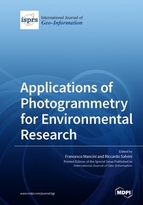Applications of Photogrammetry for Environmental Research
A special issue of ISPRS International Journal of Geo-Information (ISSN 2220-9964).
Deadline for manuscript submissions: closed (31 August 2019) | Viewed by 42455
Special Issue Editors
Interests: geomatics engineering; photogrammetry; remote sensing; surveying; spatial analysis
Special Issues, Collections and Topics in MDPI journals
Interests: engineering geology; geomorphology; remote sensing; UAV digital photogrammetry; GIS; GNSS; laser scanning
Special Issues, Collections and Topics in MDPI journals
Special Issue Information
Dear Colleagues,
This Special Issue aims to collect papers showing the progress in key areas of photogrammetry for environmental research. Papers focused on airborne, terrestrial, and unmanned aerial vehicle (UAV) photogrammetry for a wide range of environmental applications are welcome. Submitted manuscripts should mainly focus on novelties introduced by recent approaches of photogrammetry to the understanding and assessment of environmental phenomena and processes at required spatial scales. In particular, papers are expected to address the following topics:
- - Terrestrial photogrammetry for monitoring purposes;
- - UAV photogrammetry to model/assess environmental phenomena at fine spatial scale;
- - Photogrammetry for disasters prevention, monitoring, and management;
- - Processing strategies of multi-temporal datasets;
- - Integration between optical and multispectral/laser data;
- - Methodologies for real-time mapping and monitoring;
- - Change detection and deformation analysis based on photogrammetric dataset
- - Investigation of natural or anthropogenic phenomena supported by terrestrial/aerial photogrammetry
- - Novel uses of proximity surveys to geography, geomorphology, geotechnologies, landscape description, coastal studies, archaeology, etc.
Finally, all papers should introduce thorough applications of the proposed approach/methodology to demonstrate the usefulness of terrestrial/aerial photogrammetry for environmental research.
Dr. Francesco Mancini
Dr. Riccardo Salvini
Guest Editors
Manuscript Submission Information
Manuscripts should be submitted online at www.mdpi.com by registering and logging in to this website. Once you are registered, click here to go to the submission form. Manuscripts can be submitted until the deadline. All submissions that pass pre-check are peer-reviewed. Accepted papers will be published continuously in the journal (as soon as accepted) and will be listed together on the special issue website. Research articles, review articles as well as short communications are invited. For planned papers, a title and short abstract (about 100 words) can be sent to the Editorial Office for announcement on this website.
Submitted manuscripts should not have been published previously, nor be under consideration for publication elsewhere (except conference proceedings papers). All manuscripts are thoroughly refereed through a single-blind peer-review process. A guide for authors and other relevant information for submission of manuscripts is available on the Instructions for Authors page. ISPRS International Journal of Geo-Information is an international peer-reviewed open access monthly journal published by MDPI.
Please visit the Instructions for Authors page before submitting a manuscript. The Article Processing Charge (APC) for publication in this open access journal is 1700 CHF (Swiss Francs). Submitted papers should be well formatted and use good English. Authors may use MDPI's English editing service prior to publication or during author revisions.
Keywords
- photogrammetry for monitoring
- UAV photogrammetry for environmental research
- photogrammetry for disasters prevention, monitoring, and management
- photogrammetry for real-time mapping
- change detection
- multi-temporal investigation






